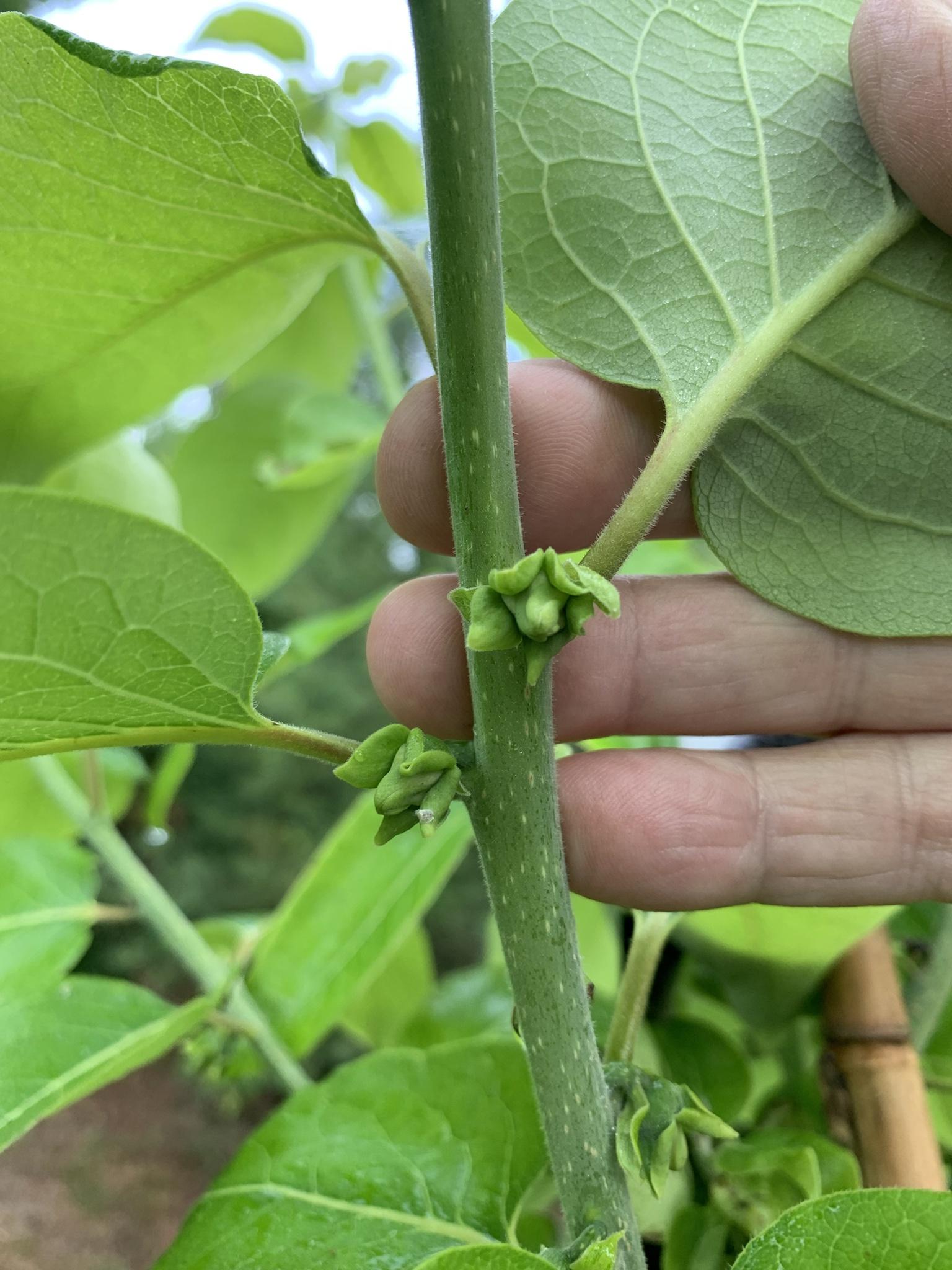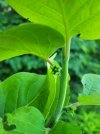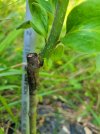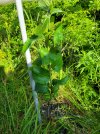I planted many persimmons about five years ago but found that the deer kept the growth down until I either caged or put a tree shelter around them. I have been grafting to these for the last two years and have grafted the following: Yates, prok, deer candy, deer magnet, Lehman’s delight, Jon’s pride, wonderful, and H63A. I am also going to try Barbra’s blush and zima khurma. I plan to give all of these the taste test eventually but I planted these primarily to attract deer during the deer season so I would like them to fall off the trees at some point during the season so that I am not just feeding raccoons and possums. Can anyone tell me from the trees that you have, if these varieties actually drop off the tree on their own or if they hang until physically removed from the tree? Thanks, Rick.
-
If you are posting pictures, and they aren't posting in the correct orientation, please flush your browser cache and try again.
Edge
Safari/iOS
Chrome
You are using an out of date browser. It may not display this or other websites correctly.
You should upgrade or use an alternative browser.
You should upgrade or use an alternative browser.
Persimmon drop times
- Thread starter R C
- Start date
yoderjac
5 year old buck +
All American persimmons are astringent protecting them from most animals until they ripen. They all fall of the tree. The timing depends on the variety and field conditions. It is only oriental persimmons that you have to worry about. They don't fall from the tree, so they don't feed deer well. Some are not astringent and get hit early by climbing critters.
You have a good mix!
You have a good mix!
Thanks, that’s what I want to hear. I have read or been told that Barbra’s blush and Morris Burton don’t fall off the tree very easily so I was becoming concerned about some of the other that I have planted. I would probably still plant them anyway but I would locate them in different areas so that I could hopefully take advantage of where they are located during the hunting season.
yoderjac
5 year old buck +
Most of the named persimmons tend to drop on the early side. They were bred for the commercial market. There is no authority for naming persimmons. Most of the varieties with "deer" in the name, were prolific trees whose persimmons had some characteristic that made them unsuited for the commercial market. Lately folks call them "deer something" and market them to deer hunters.
Native trees can have a very wide variety of drop times. I've seen some on the ground as early as Sep and others hang until Feb. I like having a wide range of drop times so there are persimmons on the ground somewhere on my land for most of the hunting season and beyond.
Native trees can have a very wide variety of drop times. I've seen some on the ground as early as Sep and others hang until Feb. I like having a wide range of drop times so there are persimmons on the ground somewhere on my land for most of the hunting season and beyond.
Native Hunter
5 year old buck +
Ask me next spring about Deer Magnet and Miller. These grafted varieties look like they will be giving me my first good crops this year. Miller is supposed to be dropping extremely well from late October well into late November in my area. That is perfect for our gun season. Deer Magnet is supposed to be a little later.
Ed Brodt
5 year old buck +
We have about a dozen mature native persimmons on our place. Not sure why but, some drop in Sept and others drop late October to mid November. Might have something to do with location. Ridge-top vs. ValleyI planted many persimmons about five years ago but found that the deer kept the growth down until I either caged or put a tree shelter around them. I have been grafting to these for the last two years and have grafted the following: Yates, prok, deer candy, deer magnet, Lehman’s delight, Jon’s pride, wonderful, and H63A. I am also going to try Barbra’s blush and zima khurma. I plan to give all of these the taste test eventually but I planted these primarily to attract deer during the deer season so I would like them to fall off the trees at some point during the season so that I am not just feeding raccoons and possums. Can anyone tell me from the trees that you have, if these varieties actually drop off the tree on their own or if they hang until physically removed from the tree? Thanks, Rick.
blueKYstream
5 year old buck +
I grafted some natives over to Barbara's Blush and Zima Khurma this year so I can't speak to size. I was hesitant to graft many of the Zima Khurma though because it's supposed to have a "low spreading growth habit". It's an Asian variety too so not sure if it holds fruit on the tree and/or is astringent. For those reasons it may not be a good wildlife tree. Again I'm not sure, so I was conservative grafting that one in particular. Have you checked out http://nuttrees.net/persimmon.html for more info?
Last edited:
yoderjac
5 year old buck +
If they are Asian, they may or may not be astringent, but won't fall from the tree for deer.I grafted some natives over to Barbara's Blush and Zima Khurma this year so I can't speak to size. I was hesitant to graft many of the Zima Khurma though because it's supposed to have a "low spreading growth habit". It's an Asian variety too so not sure if it holds fruit on the tree and/or is astringent. For those reasons it may not be a good wildlife tree. Again I'm not sure, so I was conservative grafting that one in particular. Have you checked out http://nuttrees.net/persimmon.html for more info?
blueKYstream
5 year old buck +
To be more clear, I should have said Zima Khurma is an Asian Hybrid. I think many of the others he listed are American varieties. According to England's Nursery:If they are Asian, they may or may not be astringent, but won't fall from the tree for deer.
Asian Persimmon Hybrid (Diospyros Virginiana X Kaki) - These very fine persimmons have been tested and selected for many years. They have been selected over many others for their taste, size and cold hardiness. Zone 5b and higher recommended.
Zima khurma =NB-02 Persimmon bred out of Nikitskaya Bordovaya, cold hardy and good producer of orange medium to large size fruit that ripens Late-season on a semi-vigorous tree. Has low spreading growth habit and is a beautiful specimen in the fall. Trees are very cold hardy tested down to minus -16.4 F for a long time. This cultivar was bred in Japan and brought to America by Jerry Lehman of Terre Haute, Indiana. Zone 5b to ZONE 8, tested to -16 F.
yoderjac
5 year old buck +
To be more clear, I should have said Zima Khurma is an Asian Hybrid. I think many of the others he listed are American varieties. According to England's Nursery:
Asian Persimmon Hybrid (Diospyros Virginiana X Kaki) - These very fine persimmons have been tested and selected for many years. They have been selected over many others for their taste, size and cold hardiness. Zone 5b and higher recommended.
Zima khurma =NB-02 Persimmon bred out of Nikitskaya Bordovaya, cold hardy and good producer of orange medium to large size fruit that ripens Late-season on a semi-vigorous tree. Has low spreading growth habit and is a beautiful specimen in the fall. Trees are very cold hardy tested down to minus -16.4 F for a long time. This cultivar was bred in Japan and brought to America by Jerry Lehman of Terre Haute, Indiana. Zone 5b to ZONE 8, tested to -16 F.
The hybrids are interesting. The only one I've seen reports of dropping is Nikita's Gift. So, that is the one I decided to play with. Since there is not authority for naming persimmons short of a patent or tradename and most have neither. That means we are relying on the reputation of the seller for the most part. I suspect reports of Nikita's Gift dropping when ripe were coming from folks who only thought they had Nikita's Gift. My Nikita's gift don't drop and looking at how tough the stem an calyx are, I can't see how they could.
Best of luck with your hybrids, and if you do find one that falls when ripe, be sure to let us know.
blueKYstream
5 year old buck +
I kind of thought it might be a long shot, so that's why I didn't field graft many of my native persimmons over to ZK. I did it near the entrance of my property, so I could grab a some for myself if nothing else. I saw a bloom on one of the Barbara's Blush I grafted, so I snapped a few pics of it. This was my first year grafting pears and persimmons. It's been fun learning. I had quite a bit of success for a first timer, in my mind anyways.
Attachments
yoderjac
5 year old buck +
Yep, Asian persimmons can be great for human use.I kind of thought it might be a long shot, so that's why I didn't field graft many of my native persimmons over to ZK. I did it near the entrance of my property, so I could grab a some for myself if nothing else. I saw a bloom on one of the Barbara's Blush I grafted, so I snapped a few pics of it. This was my first year grafting pears and persimmons. It's been fun learning. I had quite a bit of success for a first timer, in my mind anyways.
Thanks for the website, I actually purchased several trees from there and planted the trees right where I want them in relation to my stands. I am hopeful that once all of the trees that I have planted and grafted start producing they will provide a reliable wildlife draw along with my apple and pear trees which have yet to start producing. It will be interesting to see which fruit they prefer.I grafted some natives over to Barbara's Blush and Zima Khurma this year so I can't speak to size. I was hesitant to graft many of the Zima Khurma though because it's supposed to have a "low spreading growth habit". It's an Asian variety too so not sure if it holds fruit on the tree and/or is astringent. For those reasons it may not be a good wildlife tree. Again I'm not sure, so I was conservative grafting that one in particular. Have you checked out http://nuttrees.net/persimmon.html for more info?
yoderjac
5 year old buck +
It takes planted persimmons a long time to produce. As for preference, I think like most things, each one will have a sweet spot in time where deer prefer them over the others. The real benefit with persimmons for wildlife is you don't have any maintenance after they are established and they still produce.
yoderjac
5 year old buck +
I think Asian persimmons take a different form. I grafted some hybrids (Nikita's Gift) to native rootstock. Some, I grafted high and others I grafted low. The ones I grafted low look more like bushes than trees. The ones I grafted higher are taller, but seem to branch wildly about the graft. I think think it is just their phenotype. I don't know as much about Asian as I don't use them for wildlife because of their characteristics.I have several asian varieties planted in nov 2013 that have yet to produce
They are supposedly self fertile and seem to be growing well but have produced only a few male flowers
They are suckering like crazy
Any ideas? Thoughts?
bill
Headdigger
A good 3 year old buck
Tree Daddy are you sure that the grafts on your trees survived? You said that you planted them in 2013 and you have only seen a few male flowers. I usually get fruit on my Asian varieties by the third year after grafting. I have never noticed any male flowers. Asian persimmons have big glossy leaves compared to our native species.
Native Hunter
5 year old buck +
I saw something this year that I had never seen before - persimmon scions making flowers the year they were topworked. It only happened on one tree, and it was where I topworked to Lehman's Delight. I've seen flowers and even had significant fruit the next year after topworking, but surprised to see this the first year.


yoderjac
5 year old buck +
I saw something this year that I had never seen before - persimmon scions making flowers the year they were topworked. It only happened on one tree, and it was where I topworked to Lehman's Delight. I've seen flowers and even had significant fruit the next year after topworking, but surprised to see this the first year.

I found that happen often on newly grafted seedlings. The flower buds were formed the previous year and you happened to get scions with the buds formed. In fact, I actually had a newly grafted tree produce a persimmon in a rootmaker container on my deck. Of course, that grafted seedling does not continue to produce persimmons in subsequent years. Eight to 10 years later the grafted seedling may start producing again.
My experience parallels yours with native and planted trees. It can take 8+ years for the first persimmon, but once they start producing, they spin up quickly.
Thanks,
Jack
Native Hunter
5 year old buck +
My guess is that this tree will start producing fast - maybe next year. It’s topworked onto a 1.5 inch DBH tree and really taking off. If I hadn’t added bracing I think it would have already broken off at the graft.I found that happen often on newly grafted seedlings. The flower buds were formed the previous year and you happened to get scions with the buds formed. In fact, I actually had a newly grafted tree produce a persimmon in a rootmaker container on my deck. Of course, that grafted seedling does not continue to produce persimmons in subsequent years. Eight to 10 years later the grafted seedling may start producing again.
My experience parallels yours with native and planted trees. It can take 8+ years for the first persimmon, but once they start producing, they spin up quickly.
Thanks,
Jack
Similar threads
- Replies
- 91
- Views
- 3K



